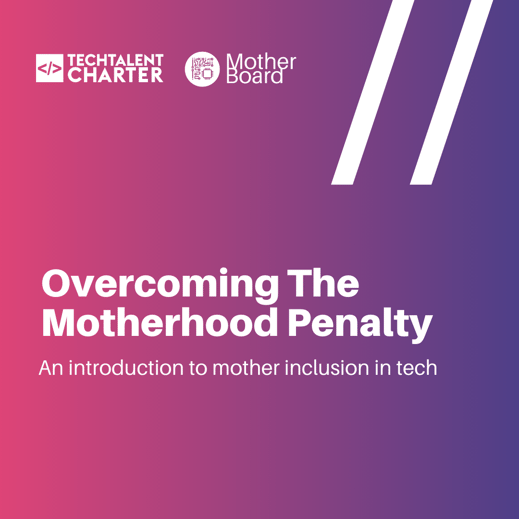'Two-thirds of working mothers say their career stalled after having children', WorkingMums. To combat barriers, promote flexible working to both men and women, measure performance by outcomes (rather than presenteeism), and empower men to be carers.
Employer recommendations
Tech Talent Charter and MotherBoard have come together to create a guide on how to overcome the Motherhood Penalty at work. This resource features case studies from industry and a list of 10 recommendations we encourage employers to commit to.
- Reframe carers at work as the norm, not the exception. Support both men and women to work flexibly and ensure the organisational culture empowers men to be carers.
- Help people managers appreciate the benefits of flexible working and how to manage flexible teams through coaching or training. Your managers are key to creating a more supportive workplace for parents.
- Issue a practical toolkit for managers to use for conversations with returners (pre-leave, during leave and post-leave). See an example here. The toolkit for managers should include a set of easy to use workflows, decision trees, tips and tools to manage complex discussions; reduces the potential for emotions to take over.
- Support managers to plan for regular communication whilst the employee is on extended leave, which takes into account the employee’s preferences about contact during leave, employee expectations about their transition back to work and a return to work plan that outlines how the arrangements will be implemented and what success will look like, and employee’s performance and career goals before the commencement of leave.
- Provide ongoing training opportunities to managers to support them to identify potential accommodations that an employee could benefit from, but may not feel comfortable asking for, to provide a more tailored return to work. Consider career transition coaching for both employees and their managers so managers are trained and prepared for any changes in role structure, and proactively offer flexible working arrangements.
- Collect success stories from within the organisation or source externally. Incorporate success stories into manager training and embed in the internal communications strategy.
➖Expand special and unique benefits, such as paid leave.
Create cultures where new carers and parents can take that time. Business In The Community (BITC) and Bain & Co. have develped an Equal Parental Leave Toolkit to support employers’ journey towards gender equality. The toolkit supports conversations on why equal parental leave is important, highlights its costs and benefits and describes how best to implement a successful equal parental leave policy.
➖Support childcare costs.
Subsidies towards ongoing childcare, holiday club provision or loans to cover nursery deposits can facilitate working for many families.
➖Offer financial assistance around fertility needs and support non-traditional families.
➖Keep track.
Monitor talent outcomes of people working different patterns to see if flexiblitiy is impacting career progression or pay.
➖Encourage people to have a healthy work-life balance.
➖Design jobs with flexibility in mind and advertise whether roles can be performed flexibly when hiring, unless there are good reasons not to.
➖Encourage a vocal culture where employees actively communicate about not only logging off but also when they are leveraging flexibility and resting.
Encourage employees and managers to be loud and vocal about their rest, personal time and space so employees feel comfortable declaring breaks, commitments, responsibilities and so on can help managers construct healthy team environments. Leverage calendar blocks, out of office and status messages to indicate flexibility and rest time
➖Make performance measurement about output.
Measure performance by results, not where and when the work gets done.
➖Talk about flexible working.
Develop the channels of communication around flexible working, for example by making it part of the 1:1 process. Use training to empower people managers to have conversations and provide tools to facilitate discussion.
➖Celebrate flex success.
Signal that flex works by publicising the flexible working patterns of
newly promoted staff and people in senior leadership roles.
➖Avoid setting expectations that people work over their contracted hours.
Performance should be monitored based on outputs rather than presenteeism.
Further information
- Report: WIW 2023: Closing the Gender Pay Gap for good: A focus on the motherhood penalty
- Guide: Managing maternity returners: A checklist for managers Resources for SMEs, Working Families
- Article: 3 Strategies to Address the Employee Well-Being Crisis, Gartner (subscription required)
- Webinar: Supporting parents & carers to thrive at work, d&i Leaders
- Report: Working Families Index 2022 – Employer action briefing, Working Families
- Article: How to support staff returning to work after a career break, People Management Magazine
- Guide: Supporting and empowering working parents before, during, and after leave, Maven
- Article: Two-thirds of working mothers say their career stalled after having children, research reveals, People Management Magazine
- Survey: Workingmums survey results 2022, WorkingMums
- Case Study: Enhanced Paternity Leave Policy at Hodge, BITC
- Resource: Equal Parental Leave Toolkit, BITC
- Article: It takes an employer: how addressing childcare can unlock diverse talent pipelines, MBS

